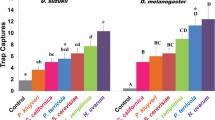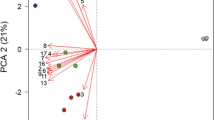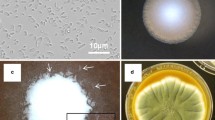Abstract
Recent work suggests that Drosophila and Saccharomyces yeasts may establish a mutualistic association, and that this is driven by chemical communication. While individual volatiles have been implicated in the attraction of D. melanogaster, the semiochemicals affecting the behavior of the sibling species D. simulans are less well characterized. Here, we scrutinized a broad range of volatiles produced by attractive and repulsive yeasts to experimentally evaluate the chemical nature of communication between these species. When grown in liquid or on agar-solidified grape juice, attraction to S. cerevisiae was driven primarily by 3-methylbutyl acetate (isoamyl acetate) and repulsion by acetic acid, a known attractant to D. melanogaster (also known as vinegar fly). By using T-maze choice tests and synthetic compounds, we showed that these responses are strongly influenced by compound concentration. Moreover, the behavioral response is impacted further by the chemical context of the environment. Thus, chemical communication between yeasts and flies is complex, and is not driven simply by the presence of single volatiles, but modulated by compound interactions. The ecological context of chemical communication needs to be taken into consideration when testing for ecologically realistic responses.


Similar content being viewed by others
References
Anagnostou C, Dorsch M, Rohlfs M (2010) Influence of dietary yeasts on Drosophila melanogaster life-history traits. Entomol Exp Appl 136:1–11
Becher PG, Flick G, Rozpedowska E, Schmidt A, Hagman A, Lebreton S, Larsson MC, Hansson BS, Piskur J, Witzgall P, Bengtsson M (2012) Yeast, not fruit volatiles mediate Drosophila melanogaster attraction, oviposition and development. Funct Ecol 26:822–828
Bergström LGW (2008) Chemical communication by behavior-guiding olfactory signals. Chem Commun 34:3959–3979
Buser CC, Newcomb RD, Gaskett AC, Goddard MR (2014) Niche construction initiates the evolution of mutualistic interactions. Ecol Lett 17:1257–1264
Capy P, Gibert P (2004) Drosophila melanogaster, Drosophila simulans: so similar, yet so different. Genetica 120:5–15
Cha DH, Adams T, Rogg H, Landolt PJ (2012) Identification and field evaluation of fermentation volatiles from wine and vinegar that mediate attraction of spotted wing Drosophila, Drosophila suzukii. J Chem Ecol 38:1419–1431
Chakir M, Peridy O, Capy P, Pla E, David JR (1993) Adaptation to alcoholic fermentation in Drosophila- a parallel selection imposed by environmental ethanol and acetic acid. Proc Natl Acad Sci U S A 90:3621–3625
Christiaens JF, Franco LM, Cools TL, De Meester L, Michiels J, Wenseleers T, Hassan BA, Yaksi E, Verstrepen KJ (2014) The fungal aroma gene ATF1 promotes dispersal of yeast cells through insect vectors. Cell Rep 9:425–432
Cordente AG, Curtin CD, Varela C, Pretorius IS (2012) Flavour-active wine yeast. Appl Microbiol Biotechnol 96:601–618
Cunningham JP, Moore CJ, Zalucki MP, West SA (2004) Learning, odor preference and flower foraging in moths. J Exp Biol 207:87–94
Dobzhansky T, Cooper DM, Phaff HJ, Knapp EP, Carson HL (1956) Differential attraction of species of Drosophila to different species of yeast. Ecology 37:544–550
Drosophila 12 Consortium (2007) Evolution of genes and genomics on the Drosophila phylogeny. Nature 450:203–218
Haldane JBS (1955) Animal communication and the origin of human language. Sci Prog 43:385–401
Hallem EA, Carlson JR (2004) The odor coding system of Drosophila. Trends Genet 20:453–459
Hallem EA, Carlson JR (2006) Coding of odors by a receptor repertoire. Cell 125:143–160
Hutner SH, Kaplan HM, Enzmann EV (1937) Chemicals attracting Drosophila. Am Nat 71:575–581
Joseph RM, Devineni AV, King IFG, Heberlein U (2009) Oviposition preference for and positional avoidance of acetic acid provide a model for competing behavioral drives in Drosophila. Proc Natl Acad Sci U S A 106:11352–11357
Knaden M, Strutz A, Ahsan J, Sachse S, Hansson BS (2012) Spatial representation of odorant valence in an insect brain. Cell Rep 1:392–399
Liti G, Carter DM, Moses AM, Warringer J, Parts L, James SA, Davey RP, Roberts IN, Burt A, Koufopanou V, Tsai IJ, Bergman CM, Bensasson D, O’Kelly MJT, van Oudenaarden A, Barton DBH, Bailes E, Ba ANN, Jones M, Quail MA, Goodhead I, Sims S, Smith F, Blomberg A, Durbin R, Louis EJ (2009) Population genomics of domestic and wild yeasts. Nature 458:337–341
MacLean RC, Gudelj I (2006) Resource competition and social conflict in experimental populations of yeast. Nature 441:498–501
Palanca L, Gaskett AC, Günther CS, Newcomb RD, Goddard MR (2013) Quantifying variation in the ability of yeasts to attract Drosophila melanogaster. PLoS ONE 8, e75332
Pfeiffer T, Schuster S, Bonhoeffer S (2001) Cooperation and competition in the evolution of ATP-producing pathways. Science 292:504–507
Phelan PL, Lin H (1991) Chemical characterization of fruit and fungal volatiles attractive to dried –fruit beetle, Carphophilus hemipterus (Coleoptera: Nitidulidae). J Chem Ecol 17:1253–1272
R Development Core Team (2008) R: A language and environment for statistical computing. R Foundation for Statistical Computing, Vienna, Austria. http://www.R-project.org
Ruebenbauer A, Schlyter F, Hansson BS, Löfstedt C, Larsson MC (2008) Genetic variability and robustness of host odor preference in Drosophila melanogaster. Curr Biol 18:1438–1443
Sachse S, Galizia CG (2003) The coding of odor intensity in the antennal lobe: local computation optimizes odor representation. Euro J Neurosci 18:2119–2132
Saerens SMG, Delvaux FR, Verstrepen KJ, Thevelein JM (2010) Production and biological function of volatile esters in Saccharomyces cerevisiae. J Microbiol Biotechnol 3:165–177
Schröder R, Hilker M (2008) The relevance of background odor in resource location by insects: a behavioral approach. Bioscience 58:308–316
Smid EJ, Kleerebezem M (2014) Production of aroma compounds in lactic acid fermentation. pp 313–326. In Doyle MP, Klaenhammer TR (ed). Annu Rev Food Sci Technol 5
Steiger S, Schmitt T, Schaefer HM (2011) The origin and dynamic evolution of chemical information transfer. Proc R Soc B Biol Sci 278:970–979
Stökl J, Strutz A, Dafni A, Svatos A, Doubsky J, Knaden M, Sachse S, Hansson BS, Stensmyr MC (2010) A deceptive pollination system targeting Drosophilids through olfactory mimicry of yeast. Curr Biol 20:1846–1852
Styger G, Prior B, Bauer FF (2011) Wine flavour and aroma. J Ind Microbiol Biotechnol 38:1145–1159
Vosshall LB, Stocker RF (2007) Molecular architecture of smell and taste in Drosophila. Annu Rev Neurosci 30:505–533
Weiss I, Roessler T, Hofferberth J, Brummer M, Ruther J, Stökl J (2013) A nonspecific defensive compound evolves into a competition avoidance cue and a female sex pheromone. Nat Commun 4:2767
Witzgall P, Proffit M, Rozpedowska E, Becher PG, Andreadis S, Coracini M, Lindblom TUT, Ream LJ, Hagman A, Bengtsson M, Kurtzman CP, Piskur J, Knight A (2012) “This is not an apple”-yeast mutualism in codling moth. J Chem Ecol 38:949–957
Wright GA, Lutmerding A, Dudareva N, Smith BH (2005) Intensity and the ratios of compounds in the scent of snapdragon flowers affect scent discrimination by honeybees (Apis mellifera). J Comp Physiol A 191:105–114
Acknowledgments
The authors gratefully acknowledge Professor Edward J. Louis (University of Leicester, UK) and Professor Wittko Francke (University of Hamburg, Germany) for helpful comments on the manuscript. We also thank Robert Winz (Plant & Food Research Ltd, New Zealand) for support with GC/MS data analysis and Anne Barrington for providing access to the insect rearing facility at The New Zealand Institute of Plant & Food Research Ltd., Auckland. This work was funded by University of Auckland Research Grants and the Swiss National Foundation Grant to Matthew R. Goddard and Claudia C Buser.
Author information
Authors and Affiliations
Corresponding author
Rights and permissions
About this article
Cite this article
Günther, C.S., Goddard, M.R., Newcomb, R.D. et al. The Context of Chemical Communication Driving a Mutualism. J Chem Ecol 41, 929–936 (2015). https://doi.org/10.1007/s10886-015-0629-z
Received:
Revised:
Accepted:
Published:
Issue Date:
DOI: https://doi.org/10.1007/s10886-015-0629-z




